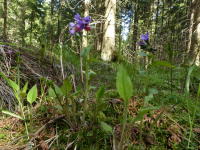Pulmonaria obscura
- Overview
- Images
- Identify
- Biology
- Taxonomy
- Occurrence
- Specimen

Growing form
Perennial herb.
Size
15–30 cm high.
Stem
The stem branches at the base and from the lower part. The stem is covered with setaceous hairs.
Leaf
The leaf arrangement is spiral. The lamina is simple and entire. The summer leaves are arranged in rosettes which emerge from the branched of the horizontal rhizome. The summer leaves are long-petiolate and the lamina is large, broadly cordate, acute, covered with setaceous hairs, with hairs of different length. The cauline leaves of the spring time floral shoot are sessile and ovate to lanceolate.
Flower
The inflorescence is a scorpioid cyme with few flowers. The distal flowers are bractless. The flowers are bisexual and bear connate floral parts. The calyx is 6–7 mm long, eventually campanulate. The lobes of the calyx are obtuse and about 1/3 of the length of the calyx. The corolla is 15 mm long, funnel-shaped, initially red and eventually blue. There are 5 tufts of hairs in the throat of the corolla. There are five stamens, and the filaments are connate with the tube of the corolla. The gynoecium has two carpels. The ovary is superior.
Fruit and seed
The mericarps are 4 mm long, pubescent, ovoid, angular, dark brown and have an elaiosome that attracts ants.
The map represents observations of this taxon, but it may not be used as a distribution map.




- 1- 315
- 10- 123
- 100- 0
- 1 000- 0
- 10 000- 0
- 100 000- 0
- Total 438 squares
- lehtoimikkä (Finnish)
- mörk lungört (Swedish)
- imikkä (Finnish)
- AOV - spontaneous, old, resident
Vascular plants – SUMI Project 2022 ?
- 2019 LC – Least Concern
- 2010 LC – Least Concern
- Arto Kurtto
- Vascular plants
- Spring flowers